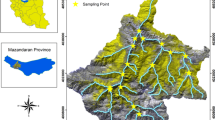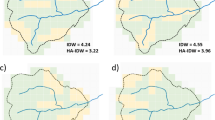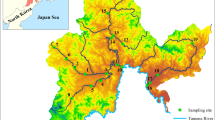Abstract
Context
Landscape composition and configuration determine the generation and exchange of water flows among different landscape patches and may affect catchment hydrological flows and variations. However, the poor understanding on the effects of landscape patterns on hydrological processes limits the implementation of landscape planning and management practices for regulating catchment water resources at the practical level.
Objectives
The aims are to determine the relationship between the landscape pattern and hydrological flows and variations, and to compare the contributions of landscape composition and configuration to the hydrological flows and variations.
Methods
Landscape patterns were quantified and hydrological flows and variations were observed in a Chinese subtropical catchment with ten sub-catchments during 2011–2017. The relationship among landscape composition, configuration, and hydrological flows and variations was analysed by Pearson correlation, and their relative contributions were determined by the variance partitioning analysis.
Results
Landscape composition and configuration were significantly correlated with catchment stream, direct, and base flows and variations, of which high fragmentation degree increased stream and base flows, great shape complexity aggravated the volatility of stream flow, high patch aggregation adversely impacted stream, direct, and base flows, and high patch evenness and lower richness increased stream and base flows. Landscape composition and configuration indices could be employed to effectively predict hydrological flows and variations.
Conclusions
Landscape configuration had greater contribution than landscape composition to subtropical catchment hydrological flows and variations, and optimizing landscape configuration could improve our regulatory capacity and ability of catchment water resources management and utilization in the subtropical catchments at the practical level.







Similar content being viewed by others
Data availability
Data available on request from the authors.
References
Alberti M, Booth D, Hill K, Coburn B, Avolio C, Coe S, Spirandelli D (2007) The impact of urban patterns on aquatic ecosystems: an empirical analysis in Puget lowland sub-basins. Landsc Urban Plan 80(4):345–361
Arnold JG, Muttiah RS, Srinivasan R, Allen PM (2000) Regional estimation of base flow and groundwater recharge in the Upper Mississippi river basin. J Hydrol 227(1–4):21–40
Baldwin DJB, Weaver K, Schnekenburger F, Perera AH (2004) Sensitivity of landscape pattern indices to input data characteristics on real landscapes: implications for their use in natural disturbance emulation. Landsc Ecol 19(3):255–271
Beven KJ (2011) Rainfall-runoff modelling: the primer. Wiley, New York
Bhaskar AS, Beesley L, Burns MJ, Fletcher TD, Hamel P, Oldham CE, Roy AH (2016) Will it rise or will it fall? Managing the complex effects of urbanization on base flow. Freshw Sci 35(1):293–310
Biswas A (2014) Landscape characteristics influence the spatial pattern of soil water storage: similarity over times and at depths. CATENA 116:68–77
Brown AE, Zhang L, McMahon TA, Western AW, Vertessy RA (2005) A review of paired catchment studies for determining changes in water yield resulting from alterations in vegetation. J Hydrol 310(1–4):28–61
Buyantuyev A, Wu JG, Gries C (2010) Multiscale analysis of the urbanization pattern of the Phoenix metropolitan landscape of USA: time, space and thematic resolution. Landsc Urban Plan 94(3–4):206–217
Cadotte MW, Jonathan Davies T, Regetz J, Kembel SW, Cleland E, Oakley TH (2010) Phylogenetic diversity metrics for ecological communities: integrating species richness, abundance and evolutionary history. Ecol Lett 13(1):96–105
Cao W, Zhou S, Wu S (2014) Land-use regionalization based on landscape pattern indices using rough set theory and catastrophe progression method. Environ Earth Sci 73(4):1611–1620
Chen SK, Liu CWI (2002) Analysis of water movement in paddy rice fields (I) experimental studies. J Hydrol 260(1–4):206–215
Chen Y, Xu YP, Yin YX (2009) Impacts of land use change scenarios on storm-runoff generation in Xitiaoxi basin, China. Quat Int 208(1):121–128
de Moraes JM, Schuler AE, Dunne T, Figueiredo RdO, Victoria RL (2006) Water storage and runoff processes in plinthic soils under forest and pasture in eastern Amazonia. Hydrol Process 20(12):2509–2526
Defries R, Eshleman KN (2010) Land-use change and hydrologic processes: a major focus for the future. Hydrol Process 18:2183–2186
DeFries R, Hansen A, Turner BL, Reid R, Liu JG (2007) Land use change around protected areas: Management to balance human needs and ecological function. Ecol Appl 17(4):1031–1038
Descheemaeker K, Nyssen J, Poesen J, Raes D, Haile M, Muys B, Deckers S (2006) Runoff on slopes with restoring vegetation: a case study from the Tigray highlands, Ethiopia. J Hydrol 331(1–2):219–241
Eitel JUH, Williams CJ, Vierling LA, Al-Hamdan OZ, Pierson FB (2011) Suitability of terrestrial laser scanning for studying surface roughness effects on concentrated flow erosion processes in rangelands. Catena 87(3):398–407
Elledge A, Thornton C (2017) Effect of changing land use from virgin brigalow (Acacia harpophylla) woodland to a crop or pasture system on sediment, nitrogen and phosphorus in runoff over 25 years in subtropical Australia. Agric Ecosyst Environ 239:119–131
Fohrer N, Haverkamp S, Frede HG (2005) Assessment of the effects of land use patterns on hydrologic landscape functions: development of sustainable land use concepts for low mountain range areas. Hydrol Process 19(3):659–672
Forman RT (1995) Land mosaics: the ecology of landscapes and regions. Cambridge University Press, Cambridge
Fu BJ, Chen LD (2000) Agricultural landscape spatial pattern analysis in the semi-arid hill area of the Loess Plateau, China. J Arid Environ 44(3):291–303
Gao H, Sabo JL, Chen X, Liu Z, Yang Z, Ren Z, Liu M (2018) Landscape heterogeneity and hydrological processes: a review of landscape-based hydrological models. Landsc Ecol 33(9):1461–1480
Glavan M, Pintar M, Volk M (2013) Land use change in a 200-year period and its effect on blue and green water flow in two Slovenian Mediterranean catchments-lessons for the future. Hydrol Process 27(26):3964–3980
Huang MB, Zhang L (2004) Hydrological responses to conservation practices in a catchment of the Loess Plateau, China. Hydrol Process 18(10):1885–1898
Hueso-Gonzalez P, Ruiz-Sinoga JD, Martinez-Murillo JF, Lavee H (2015) Overland flow generation mechanisms affected by topsoil treatment: application to soil conservation. Geomorphology 228:796–804
Hümann M, Schüler G, Müller C, Schneider R, Johst M, Caspari T (2011) Identification of runoff processes–the impact of different forest types and soil properties on runoff formation and floods. J Hydrol 409(3–4):637–649
Ide J, Kume T, Wakiyama Y, Higashi N, Chiwa M, Otsuki K (2009) Estimation of annual suspended sediment yield from a Japanese cypress (Chamaecyparis obtusa) plantation considering antecedent rainfalls. For Ecol Manag 257(9):1955–1965
Kearns FR, Kelly NM, Carter JL, Resh VH (2005) A method for the use of landscape metrics in freshwater research and management. Landsc Ecol 20(1):113–125
Kim JS, Oh SY, Oh KY (2006) Nutrient runoff from a Korean rice paddy watershed during multiple storm events in the growing season. J Hydrol 327(1–2):128–139
Kondoh A, Nishiyama J (2000) Changes in hydrological cycle due to urbanization in the suburb of Tokyo Metropolitan Area, Japan. Adv Space Res 26(7):1173–1176
Konrad CP, Booth DB, Burges SJ (2005) Effects of urban development in the Puget Lowland, Washington, on interannual streamflow patterns: Consequences for channel form and streambed disturbance. Water Resour Res. https://doi.org/10.1029/2005WR004097
Lee SW, Hwang SJ, Lee SB, Hwang HS, Sung HC (2009) Landscape ecological approach to the relationships of land use patterns in watersheds to water quality characteristics. Landsc Urban Plan 92(2):80–89
Li J, Zhou ZX (2015) Coupled analysis on landscape pattern and hydrological processes in Yanhe watershed of China. Sci Total Environ 505:927–938
Li S, Xiao H, Li S (2005) Regulation effect of microbiotic crusts on soil hydrological processes in shapotou revegetation-fixed sand dune regions. In: Proceedings. 2005 IEEE international geoscience and remote sensing symposium, 2005, IGARSS '05, pp 4443–4446.
Lin YP, Hong NM, Wu PJ, Wu CF, Verburg PH (2007) Impacts of land use change scenarios on hydrology and land use patterns in the Wu-Tu watershed in Northern Taiwan. Landsc Urban Plan 80(1–2):111–126
Long J, Nelson T, Wulder M (2010) Regionalization of landscape pattern indices using multivariate cluster analysis. Environ Manage 46:134
Marin CT, Bouten IW, Dekker S (2000) Forest floor water dynamics and root water uptake in four forest ecosystems in northwest Amazonia. J Hydrol 237(3–4):169–183
Martin KA, Van Stan JT, Dickerson-Lange SE, Lutz JA, Berman JW, Gersonde R, Lundquist JD (2013) Development and testing of a snow interceptometer to quantify canopy water storage and interception processes in the rain/snow transition zone of the North Cascades, Washington, USA. Water Resour Res 49(6):3243–3256
McGarigal K, Marks BJ (1995) FRAGSTATS: spatial pattern analysis program for quantifying landscape structure. General Technical Report PNW-GTR-351. Pacific Northwest Research Station, USDA-Forest Service, Portland. https://doi.org/10.2737/PNW-GTR-351
Molina A, Govers G, Vanacker V, Poesen J, Zeelmaekers E, Cisneros F (2007) Runoff generation in a degraded Andean ecosystem: interaction of vegetation cover and land use. CATENA 71(2):357–370
Musters PAD, Bouten W, Verstraten JM (2015) Potentials and limitations of modelling vertical distributions of root water uptake of an Austrian pine forest on a sandy soil. Hydrol Process 14(1):103–115
Nakano H (1976) Forest hydrology; Studies on hydrology, 13. [Japanese].
Neupane RP, Kumar S (2015) Estimating the effects of potential climate and land use changes on hydrologic processes of a large agriculture dominated watershed. J Hydrol 529:418–429
Ouyang W, Skidmore AK, Hao F, Wang T (2010) Soil erosion dynamics response to landscape pattern. Sci Total Environ 408(6):1358–1366
Ricart AM, Dalmau A, Pérez M, Romero J (2015) Effects of landscape configuration on the exchange of materials in seagrass ecosystems. Mar Ecol Prog Ser 532:89–100
Roberts AD (2016) The effects of current landscape configuration on streamflow within selected small watersheds of the Atlanta metropolitan region. J Hydrol 5:276–292
Robinson JC, Alberts AJ (1989) Seasonal variations in the crop water-use coefficient of banana (cultivar ‘Williams’) in the subtropics. Sci Hortic 40(3):215–225
Sander T, Gerke HH (2007) Preferential flow patterns in paddy fields using a dye tracer. Vadose Zone J 6(1):105–115
Santhi C, Allen PM, Muttiah RS, Arnold JG, Tuppad P (2008) Regional estimation of base flow for the conterminous United States by hydrologic landscape regions. J Hydrol 351(1–2):139–153
Saunders DA, Hobbs RJ, Margules CR (1991) Biological consequences of ecosystem fragmentation: a review. Conserv Biol 5:18–32
Schilling KE (2005) Relation of baseflow to row crop intensity in Iowa. Agric Ecosyst Environ 105(1–2):433–438
Shen JL, Li Y, Liu XJ, Luo XS, Tang H, Zhang YZ, Wu JS (2013) Atmospheric dry and wet nitrogen deposition on three contrasting land use types of an agricultural catchment in subtropical central China. Atmos Environ 67:415–424
Shi ZH, Ai L, Li X, Huang XD, Wu GL, Liao W (2013) Partial least-squares regression for linking land-cover patterns to soil erosion and sediment yield in watersheds. J Hydrol 498:165–176
Su SL, Hu YN, Luo FH, Mai GC, Wang YP (2014b) Farmland fragmentation due to anthropogenic activity in rapidly developing region. Agric Syst 131:87–93
Su SL, Xiao R, Li D, Hu Y (2014a) Impacts of transportation routes on landscape diversity: a comparison of different route types and their combined effects. Environ Manag 53(3):636–647
Tang LH, Yang DW, Hu HP, Gao B (2011) Detecting the effect of land-use change on streamflow, sediment and nutrient losses by distributed hydrological simulation. J Hydrol 409(1–2):172–182
Tischendorf L (2001) Can landscape indices predict ecological processes consistently? Landsc Ecol 16(3):235–254
Tomer MD, Meek DW, Kramer LA (2005) Agricultural practices influence flow regimes of headwater streams in western Iowa. J Environ Qual 34(5):1547–1558
Tscharntke T, Steffandewenter I, Kruess A, Thies C (2008) Contribution of small habitat fragments to conservation of insect communities of grassland-cropland landscapes. Ecol Appl 12(2):354–363
Wang SP, Zhang ZQ, McVicar TR, Zhang JJ, Zhu JZ, Guo JT (2012) An event-based approach to understanding the hydrological impacts of different land uses in semi-arid catchments. J Hydrol 416:50–59
Wang W, Sardans J, Zeng C, Zhong C, Li Y, Penuelas J (2014a) Responses of soil nutrient concentrations and stoichiometry to different human land uses in a subtropical tidal wetland. Geoderma 232–234:459–470
Wang Y, Li Y, Liu X, Liu F, Li Y, Song L, Li H, Ma Q, Wu J (2014b) Relating land use patterns to stream nutrient levels in red soil agricultural catchments in subtropical central China. Environ Sci Pollut Res 21(17):10481–10492
Wang Y, Liu XL, Li Y, Liu F, Shen JL, Li YY, Ma QM, Yin J, Wu JS (2015) Rice agriculture increases base flow contribution to catchment nitrate loading in subtropical central China. Agric Ecosyst Environ 214:86–95
Wang Y, Zhang B, Lin L, Zepp H (2011) Agroforestry system reduces subsurface lateral flow and nitrate loss in Jiangxi Province, China. Agric Ecosyst Environ 140(3–4):441–453
Wickham JD, Wade TG, Riitters KH, O'Neill RV, Smith JH, Smith ER, Jones KB, Neale AC (2003) Upstream-to-downstream changes in nutrient export risk. Landsc Ecol 18(2):195–208
Wu J (2013) Key concepts and research topics in landscape ecology revisited: 30 years after the Allerton Park workshop. Landsc Ecol 28(1):1–11
Wu J, David JL (2002) A spatially explicit hierarchical approach to modeling complex ecological systems: theory and applications. Ecol Model 153:7–26
Wu J, Hobbs RJ (2007) Key topics in landscape ecology. Cambridge University Press, Cambridge
Wu RS, Sue WR, Chien CB, Chen CH, Chang JS, Lin KM (2001) A simulation model for investigating the effects of rice paddy fields on the runoff system. Math Comput Model 33(6–7):649–658
Yang DW, Li C, Hu HP, Lei ZD, Yang SX, Kusuda T, Koike T, Musiake K (2004) Analysis of water resources variability in the Yellow River of China during the last half century using historical data. Water Resour Res 40(6):308–322
Yang F, Zhang GL, Yang JL, Li DC, Zhao YG, Liu F, Yang RM, Yang F (2014) Organic matter controls of soil water retention in an alpine grassland and its significance for hydrological processes. J Hydrol 519:3086–3093
Ye XC, Zhang Q, Liu J, Li XH, Xu CY (2013) Distinguishing the relative impacts of climate change and human activities on variation of streamflow in the Poyang Lake catchment, China. J Hydrol 494:83–95
Zhang G, Guhathakurta S, Dai G, Wu L, Yan L (2013) The control of land-use patterns for stormwater management at multiple spatial scales. Environ Manag 51(3):555–570
Zhang G, Guhathakurta S, Lee S, Moore A, Yan LJ (2014) Grid-based land-use composition and configuration optimization for watershed stormwater management. Water Resour Manag 28(10):2867–2883
Zhou T, Wu JG, Peng SL (2012) Assessing the effects of landscape pattern on river water quality at multiple scales: a case study of the Dongjiang River watershed, China. Ecol Indic 23:166–175
Zhou ZX, Li J (2015) The correlation analysis on the landscape pattern index and hydrological processes in the Yanhe watershed, China. J Hydrol 524:417–426
Ziegler AD, Giambelluca TW, Plondke D, Leisz S, Tran LT, Fox J, Nullet MA, Vogler JB, Troung DM, Vien TD (2007) Hydrological consequences of landscape fragmentation in mountainous northern Vietnam: buffering of Hortonian overland flow. J Hydrol 337(1–2):52–67
Acknowledgements
The authors appreciate the financial support for this study that was provided by the National Key Research and Development Program of China (2017YFD0800104), the Key Research and Development Project in Hunan Province (2017NK2150), the Key Research Projects of the CAS (QYZDJ-SSW-DQC041) and the Project of Youth Innovation Team at the Institute of Subtropical Agriculture, CAS (2017QNCXTD_LF).
Author information
Authors and Affiliations
Corresponding authors
Additional information
Publisher's Note
Springer Nature remains neutral with regard to jurisdictional claims in published maps and institutional affiliations.
Rights and permissions
About this article
Cite this article
Liu, J., Liu, X., Wang, Y. et al. Landscape composition or configuration: which contributes more to catchment hydrological flows and variations?. Landscape Ecol 35, 1531–1551 (2020). https://doi.org/10.1007/s10980-020-01035-3
Received:
Accepted:
Published:
Issue Date:
DOI: https://doi.org/10.1007/s10980-020-01035-3




